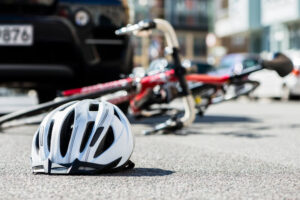When you get on a bicycle to go for a ride, you expect to get some exercise, get to a particular destination, or perhaps simply enjoy some fresh air and the outdoors.
You don’t expect an accident whose next destination is the emergency room. The next thing you know, you continue to receive medical bills and wondering if and when you can return to work.
If the unexpected happened to you, an experienced Austin bicycle accident lawyer can help. The person who caused your accident may owe you compensation to help with your financial and other concerns.
Austin Bicycle Laws
The state of Texas and the City of Austin have several laws to protect bicyclists as they share the road with others. It’s the bicyclist’s responsibility to know and understand these laws and obey them. Motorists must also follow specific laws to keep bicyclists safe on the roads, such as stopping at stop lights and signs and yielding to bike or foot traffic in a crosswalk.
The Texas State transportation code and the City of Austin code lay out the following laws regarding bicycles and other micro-mobility riders in the City of Austin:
- On the road, bicyclists must obey the same traffic laws as motorists unless a police officer, traffic signals, street signs, or facilities specific to bicycles and micro-mobility direct them otherwise.
- Children aged 17 and under must always wear helmets when riding a bicycle or micro-mobility device.
- Riding a bicycle or micro-mobility device on a sidewalk is permitted, but only in a reasonable and prudent manner.
- Riders are not legally permitted to use a portable electronic device while operating a bicycle or micro-mobility device.
- It’s illegal to ride a bicycle or micro-mobility device with another rider or occupant unless the device was designed to accommodate more than one rider.
- Parked bicycles and micro-mobility devices can’t obstruct or impede pedestrian traffic on sidewalk paths.
- Parked bicycles and micro-mobility devices can’t be attached to public or private property in such a way that they can damage the property.
- Riders who injure another person or damage property must provide reasonable assistance and give their name and contact information.
- Under Texas state law, when riding at night in the darkness, a bicycle must have the following:
A front white light visible from at least 500 feet in the front
A red reflector or light on the rear of the bicycle
Bicycle Safety Tips

Cycling is an eco-friendly mode of transportation and an excellent way to stay active and enjoy the outdoors. Whether you’re a seasoned cyclist or a beginner, prioritizing safety while riding your bicycle is paramount.
By following these bicycle safety tips, you can ensure a safer and more enjoyable experience on the road.
- Wear a helmet: Always wear a properly fitted helmet that meets or exceeds current safety standards. A well-fitting helmet can significantly reduce the risk of head injuries in the event of a fall or collision.
- Check your bike: Regularly inspect your bicycle for any mechanical issues. Ensure brakes, tires, gears, and lights function correctly before every ride.
- Obey traffic laws: Bicyclists must follow the same traffic laws as motorists. Make sure to stop at red lights and stop signs, yield the right-of-way, and signal your turns.
- Be as visible as possible: Use front and rear lights, especially when riding at dawn, dusk, or low-light conditions. Wear reflective clothing or accessories to increase your visibility to drivers. Avoid wearing dark clothing.
- Stay alert: Keep both hands on the handlebars and be aware of your surroundings. Stay focused on the road ahead and avoid distractions like texting, talking on the phone, or using headphones.
- Ride in the same direction as traffic: Always ride on the right side of the road, in the same direction as the traffic flow. Use designated bike lanes if available, or stay as far to the right as safely possible.
- Use hand signals: Signal your intentions to drivers and pedestrians by using hand signals to indicate turns and stops.
- Watch for opening car doors: Be cautious when riding near parked cars. Drivers or passengers may unexpectedly open their doors into your path when you least expect it, which can cause severe injuries.
- Maintain a safe distance: Keep a safe distance from vehicles, other cyclists, and pedestrians. This gives you ample time to react to sudden changes in traffic.
- Ride predictably: Avoid sudden swerves or maneuvers in a straight line. This helps drivers anticipate your movements.
- Be mindful of intersections: Approach intersections cautiously, even if you have the right-of-way. You never know if another driver is going to see you or stop when they should. Make eye contact with drivers to ensure they see you.
- Stay away from trucks and large vehicles: Avoid riding alongside or directly behind large vehicles, as they may have limited visibility of cyclists.
- Be cautious on shared paths: When sharing paths with pedestrians, announce your presence with a bell or a friendly “passing on your left” before overtaking them.
- Secure your belongings: Use a sturdy basket or backpack to carry your belongings securely. Loose items can interfere with your balance or get caught in your wheels, causing you to fall.
- Prepared for bad weather: Adjust your riding style and take precautions in adverse weather conditions. Remember that rain, wind, and poor visibility can affect your safety.
- Learn basic bike handling skills: Practice essential bike handling skills, such as braking, turning, and balancing, in a safe and controlled environment.
- Educate children: Teach young cyclists the importance of bicycle safety rules and lead by example.
By incorporating these bicycle safety tips into your cycling routine, you can enjoy the many benefits of biking while minimizing potential risks. Ride confidently, follow traffic laws, and promote a culture of respect and awareness for all road users.
Causes of Bicycle Accidents
Dooring Incidents
Dooring incidents occur when a driver or passenger opens a car door without first checking to see if there are approaching cyclists. These accidents frequently happen in urban settings where cyclists share lanes with parked vehicles. The sudden appearance of an open door can catch cyclists off guard and lead to severe crashes.
To prevent dooring incidents, motorists should practice the Dutch Reach, which involves using the hand farthest from the door to open it. This action naturally turns the body and encourages looking for cyclists before opening the door.
Intersection Mishaps
Intersections can be hotspots for bicycle accidents due to misunderstandings between cyclists and drivers. In some cases, a driver may fail to spot a cyclist while making a turn, especially during right turns at intersections.
Similarly, cyclists may misjudge a driver’s intentions, leading to collisions when both parties attempt to navigate the intersection simultaneously.
Clear communication, adherence to traffic signals, and cautious maneuvering are essential at intersections to mitigate the risk of mishaps.
Distracted Driving and Riding
The rise of technology has introduced new risks to road safety, with both motorists and cyclists becoming prone to distractions. Using smartphones, navigation systems, or other devices diverts attention from the road and diminishes reaction times.
For cyclists, distraction can result in accidents as it reduce awareness of traffic dynamics. To counter this, drivers and cyclists should prioritize focusing solely on the road while in transit.
Unsafe Passing
Unsafe passing occurs when motorists pass cyclists in close proximity or without allowing sufficient clearance. This behavior endangers cyclists by failing to provide adequate space to maneuver and react to sudden changes.
To ensure the safety of cyclists, drivers must adhere to passing laws, which often require maintaining a safe distance when overtaking a cyclist.
Poor Road Conditions
Cyclists are particularly vulnerable to poor road conditions, including uneven surfaces, potholes, debris, and slippery areas. These hazards can disrupt a cyclist’s balance and control, potentially leading to falls or collisions.
Municipalities and road maintenance authorities play a crucial role in preventing accidents by promptly addressing road defects and ensuring safe cycling environments.
Lack of Visibility
Cyclists without proper visibility equipment, such as lights, reflectors, and reflective clothing, pose a challenge for motorists, especially in low-light conditions. Inadequate visibility reduces drivers’ chances of noticing cyclists, increasing the risk of accidents.
Cyclists should prioritize enhancing their visibility through appropriate gear and clothing choices.
Inadequate Signaling
Proper communication among road users is essential for safe navigation. Cyclists should use hand signals to indicate turns and stops, allowing motorists and other cyclists to anticipate their movements. Failure to signal can lead to confusion and potential collisions, highlighting the importance of clear communication on the road.
Alcohol and Drug Impairment
Impaired driving or riding is a significant contributor to bicycle accidents. Alcohol and drugs impair judgment, coordination, and reaction times, reducing the ability to make informed decisions and respond to changing road conditions.
Both motorists and cyclists should avoid cycling while under the influence to ensure their safety and the safety of others.
Turning Conflicts
Conflicts often arise when vehicles and cyclists attempt to make turns simultaneously or without proper signaling. Misjudging the speed or intention of the other party can result in bicycle collisions, emphasizing the need for communication, patience, and cautious maneuvering at intersections.
Inexperienced Cyclists
Novice cyclists may lack the skills and confidence to navigate complex traffic situations or handle unexpected challenges. Inexperience can lead to poor decision-making, improper signaling, and difficulty maintaining control, all of which increase the risk of accidents. Novice cyclists should prioritize skill-building and seek guidance to become more proficient riders.
Aggressive Behavior
Aggressive behaviors contribute to an unsafe road environment, such as tailgating, weaving in and out of traffic, and confrontations between motorists and cyclists.
Escalating tensions on the road can lead to accidents and compromise the safety of all road users. A calm, patient approach prevents aggressive behaviors and maintains a harmonious road atmosphere.
Speeding
Excessive speed, whether by cyclists or motorists, reduces the time available to react to unexpected obstacles or changes in traffic flow. Cyclists traveling at high speeds may find it challenging to anticipate and respond to sudden changes in road conditions.
Accidents at higher vehicle speeds are typically more severe and cause more damage than those at lower speeds.
Negligent Road Design
Poorly designed or maintained roads, lack of proper signage, and the absence of dedicated cycling lanes can contribute to accidents. Inadequate road infrastructure may force cyclists to share busy roads with motor vehicles, heightening the risk of collisions. Municipal authorities should prioritize safe road design and cycling infrastructure to create a secure cyclist environment.
Bicycle Accidents Often Arise From Negligence
Bicycle accidents often arise from the negligence of other people or parties, such as drivers, auto manufacturers, or government entities.
A negligent person fails to take the same action as a reasonably prudent person in similar circumstances. Negligence alone does not give merit to an injury case; when negligence causes injuries and damages, a claim is possible.
The injured individual’s bicycle accident lawyer must establish the following to win an injury claim based on negligence:
- The at-fault party owed a duty of care, such as driving safely and paying attention
- The bicycle accident lawyer violated that duty by speeding, texting, or some other means
- The at-fault party’s violation of their duty caused the accident, which caused your injuries
- Because of your injuries, you suffered losses such as medical bills, lost income, and pain and suffering
Did You Suffer Injuries in a Bicycle Accident? Contact a Skilled Austin Bicycle Accident Lawyer Today
Unfortunately, bicycle accidents are frequent occurrences in Austin. You have legal rights if you or someone you love suffered injuries in a bicycle accident here.
Contact a personal injury law firm in Austin today to learn more about them and pursue the compensation you deserve for your damages. An attorney can help you through every step of the personal injury process.


